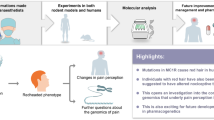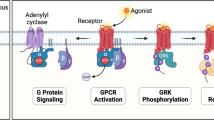Abstract
We have previously reported that the protein filamin A (FLA) binds to the carboxyl tail of the mu opioid receptor (MOPr). Using human melanoma cells, which do not express filamin A, we showed that receptor down-regulation, functional desensitization and trafficking are deficient in the absence of FLA (Onoprishvili et al. Mol Pharmacol 64:1092–1100, 2003). Since FLA has a binding domain for actin and is a member of the family of actin cytoskeleton proteins, it is usually assumed that FLA functions via the actin cytoskeleton. We decided to test this hypothesis by preparing cDNA coding for mutant FLA lacking the actin binding domain (FLA-ABD) and expressing FLA-ABD in the human melanoma cell line M2 (M2-ABD cell line). We report here that this mutant is capable of restoring almost as well as full length FLA the down-regulation of the human MOPr. It is similarly very effective in restoring functional desensitization of MOPr, as assessed by the decrease in G-protein activation after chronic exposure of M2-ABD cells to the mu agonist DAMGO. We also found that A7 cells, expressing wild type FLA, exhibit rapid activation of the MAP kinases, ERK 1 and 2, by DAMGO, as shown by a rise in the level of phospho-ERK 1 and 2. This is followed by rapid dephosphorylation (inactivation), which reaches basal level between 30 and 60 min after DAMGO treatment. M2 cells show normal activation of ERK 1 and 2 in the presence of DAMGO, but very slow inactivation. The rapid rate of MAPK inactivation is partially restored by FLA-ABD. We conclude that some functions of FLA do not act via the actin cytoskeleton. It is likely that other functions, not studied here, may require functional binding of the MOPr-FLA complex to actin.




Similar content being viewed by others
Abbreviations
- GPCR:
-
G protein-coupled receptor
- FLA:
-
Filamin A
- MOPr:
-
Mu opioid receptor
- ABD:
-
Actin-binding domain
- FLA-ABD:
-
FLA deletion mutant lacking ABD
- DAMGO:
-
[d-Ala2, N-Me-Phe4,Gly5-ol]enkephalin
- MAPK:
-
Mitogen-activated protein kinase
- ERK:
-
Extracellular signal-regulated kinase (member of MAPK family)
- GTPγS:
-
Guanosine 5′-3-O-(thio)triphosphate
- M2-ABD:
-
M2 cells containing FLA-ABD cells
References
Onoprishvili I, Andria ML, Kramer HK et al (2003) Interaction between the mu opioid receptor and filamin A is involved in receptor regulation and trafficking. Mol Pharmacol 64:1092–1100
Gorlin JB, Yamin R, Egan S et al (1990) Human endothelial actin-binding protein (ABP-280, nonmuscule filamin): a molecular leaf spring. J Cell Biol 111:1089–1105
Stossel TP, Condeelis J, Cooley L et al (2001) Filamins as integrators of cell mechanics and signalling. Nat Rev Mol Cell Biol 2:138–145
Loo DT, Kanner SB, Aruffo A (1998) Filamin binds to the cytoplasmic domain of the beta1-integrin. J Biol Chem 273:233004–223312
Xu BW, Xie ZW, Chung DW et al (1998) A novel human actin-binding protein homologue that binds to platelet glycoprotein Ibalpha. Blood 92:1268–1276
Zhang J, Ferguson SSG, Barak LS et al (1998) Role for G protein-coupled receptor kinase in agonist-specific regulation of μ-opioid receptor responsiveness. Proc Natl Acad Sci USA 95:7157–7162
Onoprishvili I, Simon EJ (2007) Chronic morphine treatment up-regulates mu opioid receptor binding in cells lacking filamin A. Brain Res 1177:9–18
Gutkind JS (1998) The pathway connecting G-protein-coupled receptors to the nucleus through divergent mitogen-activated protein kinase cascades. J Biol Chem 273:1839–1842
Polakiewicz RD, Schieferl SM, Dorner LF et al (1998) A mitogen-activated protein kinase pathway is required for mu-opioid receptor desensitization. J Biol Chem 273:12402–12406
Trapaidze N, Gomes I, Cvejic S et al (2000) Opioid receptor endocytosis and activation of MAP kinase pathway. Brain Res Mol Brain Res 76:220–228
Kramer HK, Simon EJ (2000) Mu and delta opioid receptor agonists induce mitogen-activated protein kinase (MAPK): activation in the absence of internalization. Neuropharmacology 39:1707–1719
Schmidt H, Schulz S, Klutzny M et al (2000) Involvement of mitogen-activated protein kinase in agonist-induced phosphorylation of the mu opioid receptor in HEK 293 cells. J Neurochem 74:414–422
Kim EY, Ridgway LD, Dryer SE (2007) Interactions with filamin A stimulate surface expression of large-conductance Ca2+-activated K+ channels in the absence of direct actin binding. Mol Pharmacol 72:622–630
Sasaki A, Masuda Y, Ohta Y et al (2001) Filamin associates with Smads and regulates transforming growth factor-beta signaling. J Biol Chem 276:17871–17877
Li M, Bermak JC, Wang ZW et al (2000) Modulation of dopamine D2 receptor signaling by actin-binding protein (ABP-280). Mol Pharmacol 57:446–452
Lin R, Karpa K, Kabbani N et al (2001) Dopamine D2 and D3 receptors are linked to the actin cytoskeleton via interaction with filamin A. Proc Natl Acad Sci USA 98:5258–5263
Cho EY, Cho DI, Park JH et al (2007) Roles of protein kinase C and actin-binding protein 280 in the regulation of intracellular trafficking of dopamine D3 receptor. Mol Endocrinol 21:2242–2254
Li M, Li C, Weingarten P et al (2002) Association of dopamine D3 receptors with actin-binding protein 280 (ABP-280). Biochem Pharmacol 63:859–863
Kim KM, Gainetdinov RR, Laporte SA et al (2005) G protein-coupled receptor kinase regulates dopamine D3 receptor signaling by modulating the stability of a receptor/filamin/beta-arrestin complex: a case of autoreceptor regulation. J Biol Chem (in press)
Scott MG, Pierotti V, Storez H et al (2006) Cooperative regulation of extracellular signal-regulated kinase activation and cell shape change by filamin A and beta-arrestins. Mol Cell Biol 26:3432–3445
Hjalm G, MacLeod RJ, Kifor O et al (2001) Filamin-A binds to the carboxyl-terminal tail of the calcium-sensing receptor, an interaction that participates in CaR-mediated activation of mitogen-activated protein kinase. J Biol Chem 276:34880–34887
Awata H, Huang C, Handlogten ME et al (2001) Interaction of the calcium-sensing receptor and filamin, a potential scaffolding protein. J Biol Chem 276:34871–34879
Zhang M, Breitwieser GE (2005) High affinity interaction with filamin A protects against calcium-sensing receptor degradation. J Biol Chem 280:11140–11146
Huang C, Wu Z, Hujer KM et al (2006) Silencing of filamin A gene expression inhibits Ca2+-sensing receptor signaling. FEBS Lett 580:1795–1800
Seck T, Baron R, Horne WC (2003) Binding of filamin to the C-terminal tail of the calcitonin receptor controls recycling. J Biol Chem 278:10408–10416
He HJ, Kole S, Kwon YK et al (2003) Interaction of filamin A with the insulin receptor alters insulin-dependent activation of the mitogen-activated protein kinase pathway. J Biol Chem 278:27096–27104
Enz R (2002) The actin-binding protein filamin-A interatcs with the metabotropic glutamate receptor type 7. FEBS Lett 514:184–188
Enz R, Croci C (2003) Different binding motifs in metabotropic glutamate receptor type 7b for filamin A, protein phosphatase 1C, protein interacting with protein kinase C (PICK) 1 and syntenin allow the formation of multimeric protein complexes. Biochem J 372:183–191
Zhang T, Xu Q, Chen FR et al (2004) Yeast two-hybrid screening for proteins that interact with alpha1-adrenergic receptors. Acta Pharmacol Sin 25:1471–1478
Nakamura F, Osborn TM, Hartemink CA et al (2007) Structural basis of filamin A functions. J Cell Biol 179:1011–1025
Acknowledgments
We thank Drs. Thomas P. Stossel, Y. Ohta and F. Nakamura for providing us with the M2 and A7 melanoma cells and the FLA cDNA construct. This work was supported by NIDA grant DA00017 to EJS and a Fellowship from NIDA Training Grant DA-07254 to IO.
Author information
Authors and Affiliations
Corresponding author
Additional information
Special issue article in honor of Dr. Ji-Sheng Han.
Rights and permissions
About this article
Cite this article
Onoprishvili, I., Ali, S., Andria, M.L. et al. Filamin A Mutant Lacking Actin-Binding Domain Restores Mu Opioid Receptor Regulation in Melanoma Cells. Neurochem Res 33, 2054–2061 (2008). https://doi.org/10.1007/s11064-008-9684-y
Received:
Accepted:
Published:
Issue Date:
DOI: https://doi.org/10.1007/s11064-008-9684-y




